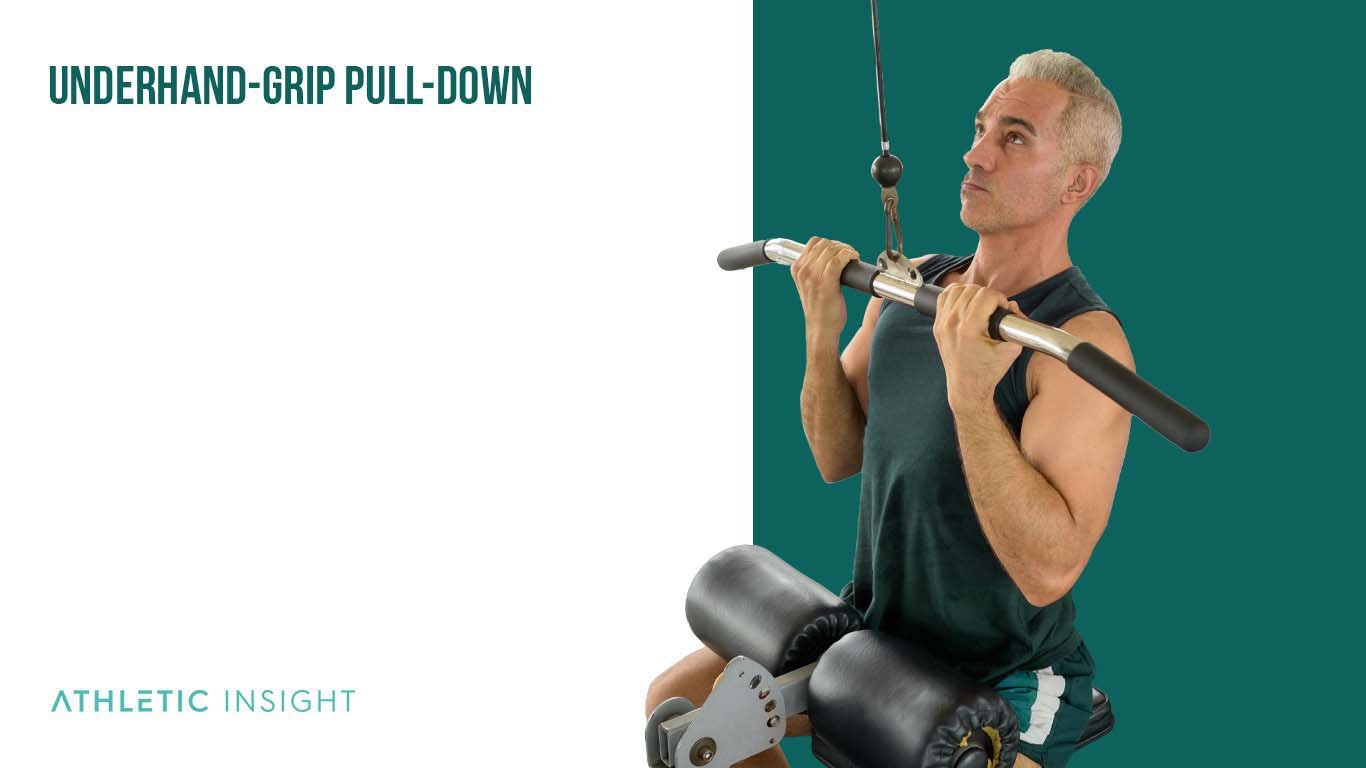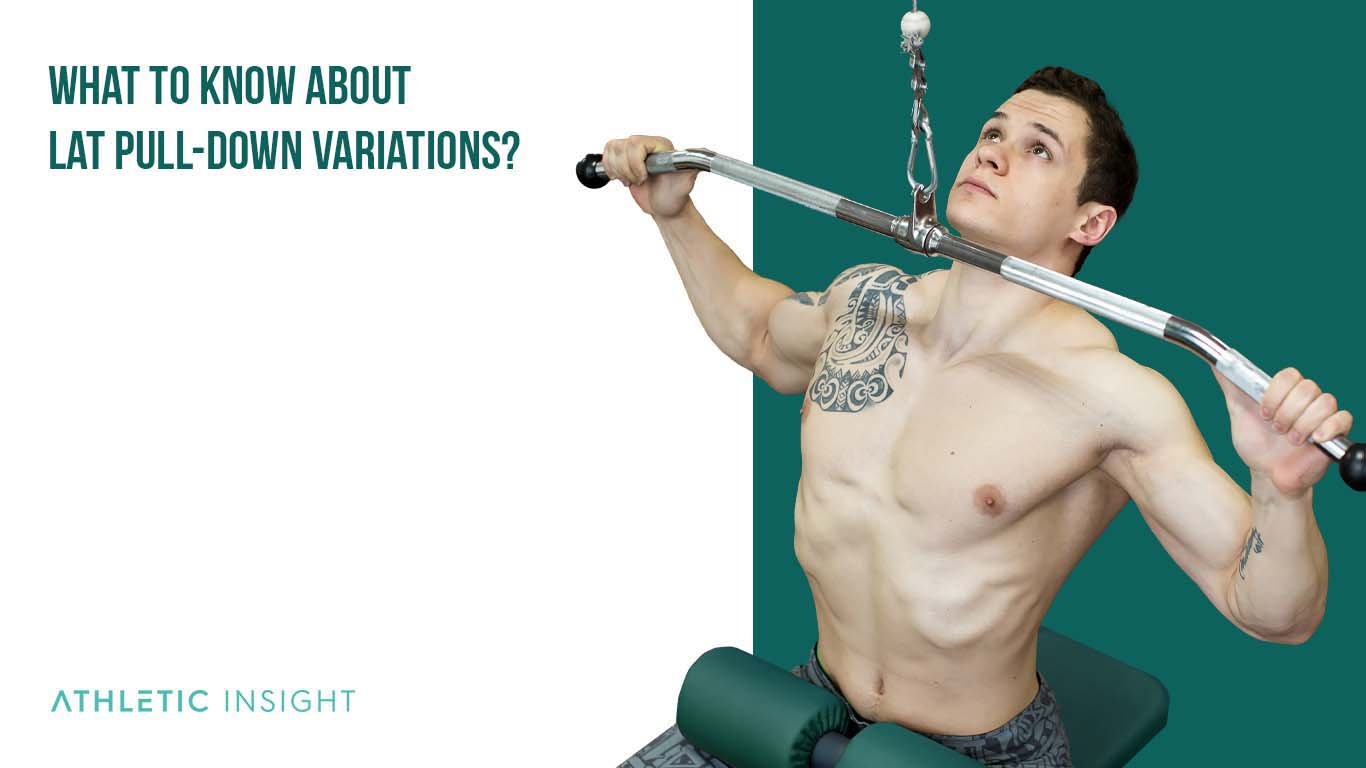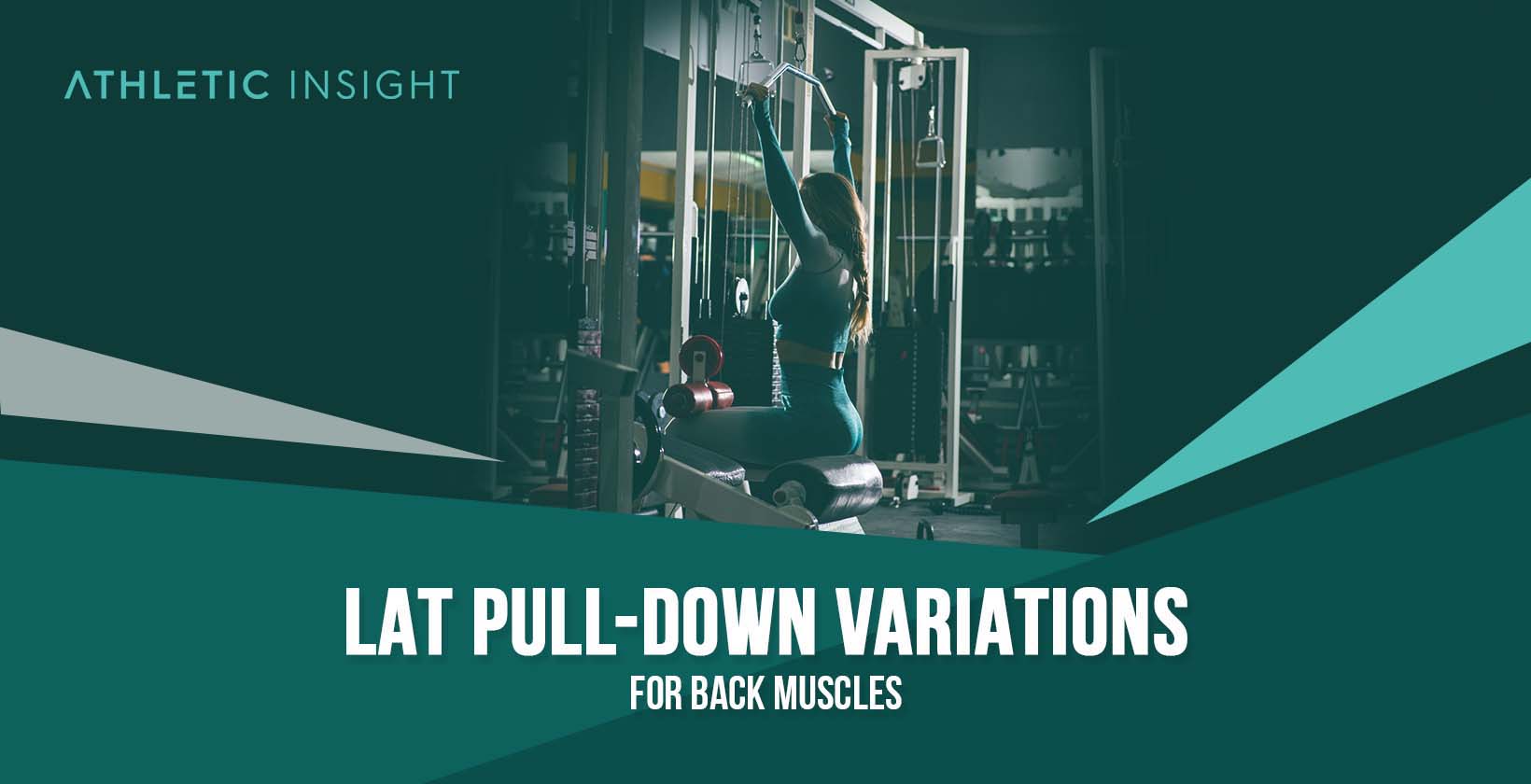A lat pull-down is an exercise that targets the latissimus dorsi, rhomboids, and trapezius muscles in your upper back. By having a wide grip on the bar and an overhand grip, users can successfully target their upper back to build bigger growth, making it a good exercise for bodybuilders and weightlifters.
Some users may want to find lat pulldown variations to build bigger back muscles. A variation is a type of exercise that is similar to the original exercise but may use different rip, equipment, or movement to target muscles to varying degrees. Instead of solely focusing on the upper back muscles, lat pull-down variations may also target the deltoid muscles, rhomboids, and biceps.
The positive effects for different back muscles make the lat pulldown a balanced and well-rounded exercise. The lat pull-down variations are effective for building different muscles in the back. Instead of solely focusing on the upper back, lat pulldown variations can include the lower back, middle back, shoulders, chest, biceps, and triceps. The lat pulldown can strengthen the lower back for running, improve postural stability in the middle back, improve shoulder strength for overhead motions, and improve the pulling strength that is useful in sports.
The common mistakes while performing this exercise is using your momentum, pulling the weight down too far, rounding your upper back, and using a weight that is too heavy.
The benefits of doing lat pulldowns for calisthenic athletes are to help with bodyweight movements, such as pushups, pullups, muscle-ups, and bodyweight planks. The effect of lat pulldowns for bodybuilders is to build the upper back and create a V-shape in the body. Lat pulldowns for swimmers can help with upper body strength and stroke motions in the water. Lastly, lat pulldowns for runners can help balance upper and lower body strength.
The lat pull-down exercise in the traditional form is performed by sitting on the seat and reaching your arms overhead to grab the bar. Grab the bar with the overhand grip and keep your hands a little wider than your shoulders. Pull the bar down by bringing your elbows close to your sides. Avoid rounding your back and keep your chest upright during the entire movement. Press the bar down and keep your elbows by your sides, and slowly return the bar to the starting position.
This exercise should be done in the gym approximately 2-3 times per week to supplement pushing exercise. If you go to the gym to do ‘arm’ day, you might consider super-setting this exercise with a pushing exercise, such as the chest press machine, dumbbell chest press, barbell chest press, or push-ups.
Individuals of any level can use this machine safely. Since it is a machine, you can easily adjust the weight. The lat pulldowns are effective for women, men, athletes, bodybuilders, weightlifters, and rare gym-goers. The best starting point is beginning with 3 sets of 10-12 reps and mastering proper lat pulldown form. The best weight to lift for lat pulldowns will depend on if the person can do a bodyweight pull-up or if they need a beginner version. The beginner weight for lat pulldowns is typically 85 pounds for beginner males and 43 pounds for beginner females. Once it becomes easy, slowly build the weight as the last lat pulldowns become too light.
1. Neutral-grip Pull-down
The neutral-grip pull-down is a lat pull-down variation that uses a neutral grip instead of an overhand grip. The natural grip variation keeps your palm facing one another instead of facing downwards. You will need to use another type of bar for this exercise, such as the v-bar since you cannot use a neutral grip with the flat bar.
Variations to this type of exercise include the overhand grip pull-down, underhand-grip pull-down, rope handle pull-down, and push-ups. One mistake that users need to avoid is switching the grip during the movement. Users can avoid this mistake by keeping their elbows close to their bodies and keeping their chest upright.
The toughness of this movement is a 4 out of 10 since it can be easily performed on a machine with the weight on a pre-set track.
2. Overhand-grip Pull-down
The overhand-grip pull-down is a lat pull-down variation that uses the overhand grip to tax the latissimus dorsi, rhomboids, and trapezius muscles. The overhand grip is suitable for beginner weightlifters and bodybuilders who want to build their upper back.

Users should avoid doing the overhand-grip pull-down by bringing their chest down during the movement. Users need to keep their chest upright and avoid pulling with their arms at a very bent angle. Some variations to this exercise include the underhand-grip pull-down and single-arm pull-down.
3. Underhand-grip Pull-down
The underhand-grip pull-down is a lateral pull-down variation that uses the underhand-grip to focus more on the biceps brachii instead of the triceps brachii during the movement. The underhand grip is suitable for beginners, bodybuilders, and weightlifters.

One mistake that users may make during this exercise is to bend their upper back to pull the bar. Users need to keep their back straight and their chest upright during the full range of motion. Some variations of the underhand-grip pull-down are the overhand-grip pull-down, bicep curls, and chin-ups.
4. Rope Handle Pull-down
The rope handle pull-down is a lat pull-down variation that requires more grip strength and can tax the forearm, wrist, and triceps. This exercise is suitable for beginners, bodybuilders, and weightlifters who want to work the back of their arms.
The variants of the rope handle pull-down are the T-bar pulldown, tricep dips, and tricep overhead extension. Users need to avoid mistakes when doing this exercise by bending over with their upper body. Users can prevent this mistake by keeping an upright back and keeping their elbows tucked into their sides.
The toughness of this exercise is a 5 out of 10 since it requires a proper lat pulldown form to be completed safely.
5. Single-arm Pull-down
The single-arm pull-down is a lat-pull-down variation that uses only one side of the body, taxing the core and the triceps. This exercise is suitable for advanced users and bodybuilders who want to build their upper back and triceps.
Variations to the single-arm pull-down exercise are single-arm cable pull-down, two-arm lat pull-down, rope pull-down, and single-arm overhead tricep extension. Mistakes that users may make with this exercise are leaning on one side of their body. Users can avoid this mistake by staying upright and focusing on their core strengths.
The toughness of this exercise is a 6 out of 10 because it requires proper form and rigidity in the body to avoid overcompensating.
6. Half-kneeling (Full-kneeling Pull-down)
What muscles do lat pulldowns work? The half-kneeling (full-kneeling pull-down) is a lat pull-down variation that taxes the upper back, trapezium, rhomboids, and triceps. This exercise removes any leg momentum and makes it harder for individuals by kneeling on the ground.
Some half-kneeling or full-kneeling pull-down exercise variations include the standing pull-down, rope cable pull-down exercise, and single-arm bent-over row. Mistakes in this exercise include leaning with the upper body. Users can avoid this mistake by breaking their core and staying upright with their chest.
The toughness of this exercise is a 6 out of 10 because it requires extra core strength and balance.
7. Wide-Grip Lat Pull-Down
The wide-grip lat pull-down is a lat pull-down alternative that focuses on the upper back, trapezius, and triceps. Because of the wide grip, this is a suitable exercise for bodybuilders and weightlifters.
Variations of wide-grip lat pulldown exercises include the close-grip pull-down exercise, lat pull-down, and wide-grip barbell bent-over row. One mistake to avoid in this exercise is bending your upper back while pulling. Users can avoid this mistake by keeping an upright chest and keeping their hands wide on the bar.
8. Behind-The-Neck Lat Pull-Down
The behind-the-neck lat pull-down is a lat pull-down alternative that focuses on the rhomboids, trapezius, and triceps. Since it is behind the neck, this alternative is good for experienced bodybuilders.
Variations of this exercise include the regular lat pull-down, wide-grip lat pull-down, overhand lat pull-down, and underhand lat pull-down. One mistake that users may make is bending their necks too far forwards. Users need to avoid slamming the weight against their neck and bending their neck towards their chest.
The toughness level of this exercise is a 7 out of 10 because it can be dangerous if not done correctly. Users need to learn how to do lat pulldowns before performing this exercise properly.
9. V-Bar Pull-Down
The v-bar pull-down is a lat pull-down alternative that taxes the biceps more so than the triceps. Since the v-bar can use a neutral grip, bodybuilders will use this alternative to focus on their biceps and their upper back.
Variations of these pull-downs include the pronated lat pull-down, overhand pull-down, underhand pull-down, and bicep curls. One mistake to avoid during this exercise is to lean too far back. Users should focus on keeping a flat back and bringing the weight to their chest.
What to know about Lat Pull-Down variations?
There are many reasons why athletes should perform lat pull-down variations instead of just the typical lat pull-down exercise.

- Muscle Growth: Lat Pull-Down Alternatives can benefit certain muscle groups better than Lat Pull-Down, such as the rhomboids, deltoids, biceps, triceps, and trapezius.
- Injury Prevention: Lat pull-down variations can prevent overuse injuries that may occur with consistent lat pull-down movements.
- Balance: Lat pull-down variations can provide more muscular balance than just doing the lat pull-down machine.
The benefits of doing the lat pull-down vs. alternative exercises include the compound benefits of taxing multiple muscle groups, functional movement in the upper body, and muscular growth. The lat pull-down can help athletes, such as runners and swimmers, along with beginner gym-goers and bodybuilders alike.
What Are the Common Mistakes in Doing the Lat Pulldown Exercises?
There are numerous mistakes that can occur while learning how to properly do lat pulldowns and perform the pull-down back exercise safely.
- Rounding the upper back – Rounding the upper back while pulling the weight down can cause postural issues.
- Not bringing the weight down enough – Bringing the bar only down to the head height will not provide a full range of motion and mobility.
- Neck forward – Straining your neck forward will agitate your neck and upper back muscles.
- Heavyweight – A weight that is too heavy will cause issues that will lead to muscular strain.
Which Type of Lat Pulldown Variation Is Beginner-Friendly?
Lat pull-down overhand grip and lat-pulldown underhand grip are lat pulldown variations that are good for beginners who need an easy to learn and simple exercise. Beginners of all ages, male or female, will benefit from these beginner-friendly lat pulldown variations. It is good for beginners since it has an easy form that is fast to learn.
One mistake to avoid is to pull the bar too far downward and round your upper back. Two ways to improve this form is to keep your chest upright and only pull the bar down to eye level. The hardness level of this exercise is a 4 out of 10 with proper form.
Which Type of Lat Pulldown Variation Is Good for Weightlifters?
The wide-grip lat pull-down, rope handle lat pull-down, and underhand-grip pulldown are lat pulldown variations that are good for weightlifters. Weightlifters who are serious about getting stronger, whether it be males or females with prior gym background, can use these lat pulldown variations to increase their upper body strength.
It should be chosen for weightlifters who already have experience with the traditional form of lat pulldown and need to increase other muscle strength. One mistake to avoid is to use too wide of a grip during the wide-grip lat pulldown. Two tips to avoid this mistake is to reach your arms up overhead and extend them until they are straight and use this grip. Another tip to prevent a form mistake is to keep your chest upright and your head facing forward.
Which Type of Lat Pulldown Variation Is Good for Athletes?
The regular lat pull-down exercise and the single-arm pulldown variation are the best options for athletes. This exercise is good for male and female athletes of all ages since it is easy to perform and good for balancing the upper body strength.
It is good for athletes who need to create symmetrical strength. This exercise should be chosen for those who do single-arm sports, such as tennis or baseball. One mistake to avoid doing the single-arm pulldown is to lean your body to one side. Individuals can avoid this mistake by keeping their core tight and only moving at their shoulders.
Which Type of Lat Pulldown Variation Is Good for Bodybuilders?
The wide-grip lat pulldown is a lat pulldown variation that is good for bodybuilders. Bodybuilders who already have experience doing the normal lat pulldown can use the wide-grip variation, whether they are male or female at any age. The only requirement is prior experience in the gym and with the lat pulldown exercise before doing the wide-grip version.
It is good for bodybuilders since it will help build the size of the upper back. This exercise should be chosen for athletes who need to increase their mass and hypertrophy. One mistake to avoid is to lean your body back too far. Users can avoid this mistake by keeping their chest upright and pinching their upper back.
What Are the Alternatives of Lat Pull-Down Exercises?
The alternatives to the lat pull-down exercise include the following.
- Neutral-grip pull-down
- Overhand-grip pull-down
- Underhand-grip pull-down
- Rope handle pull-down
- Single-arm pull-down
- Half-kneeling pull-down
- Full-kneeling pull-down
- Behind-the-neck lat pull-down
- V-bar pull-down



